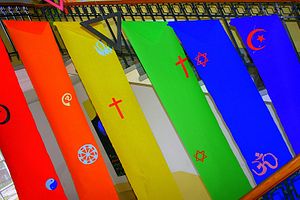Asia leads the world in religious diversity, according to a new poll.
The Pew Research Center recently released the second phase of its Pew-Templeton Global Religious Futures project, “which analyzes religious change and its impact on societies around the world.” The new study measures religious diversity across around 200 countries and territories across the world, based on the “percentage of each country’s population that belongs to eight major religious groups.” These are the five major religious groups in the world—Buddhism, Christianity, Hinduism, Islam and Judaism—as well as the religiously unaffiliated, adherents of folk or traditional religions, and those belonging to the remaining religious groups (“such as the Baha’i faith, Jainism, Shintoism, Sikhism, Taoism, Tenrikyo, Wicca and Zoroastrianism.”)
Categorizing religion in this way allowed Pew to compare religious diversity across the wide sway of nations and territories covered in the survey. Each country included in the survey is given a religious diversity ranking, with 10 being the highest ranking a country can receive.
The Asia-Pacific ranks exceptionally high on Pew’s resulting Religious Diversity Index. As a press release announcing the report notes, “half of the most religiously diverse countries are in the Asia-Pacific region.” Moreover, the region as a whole scored 9.2 on Pew’s Religious Diversity Index. The next most religiously diverse region was sub-Saharan Africa, with an RDI score of just 5.8.
Hindus were the largest religious group in the Asia-Pacific, comprising around 25 percent of the region’s population. This was followed by Muslims, who made up 24 percent of the population, and unaffiliated people who accounted for 21 percent of Asians.
Asia-Pacific nations also took the top three spots in the Religious Diversity Index, with Singapore coming in first with a score of 9, Taiwan coming in second with a score of 8.2, and Vietnam rounding out the top three spots with a score of 7.7. Among the twelve nations and territories Pew ranks as having very high levels of religious diversity—defined as those scoring 7 or higher—exactly half of them are in the Asia Pacific. Besides the three countries just listed, South Korea, China and Hong Kong are included in the countries and territories with very high levels of religious diversity.
The Asia-Pacific also makes a strong showing in the grouping of nations and territories with a high level of religious diversity—which is defined by Pew as those with scores ranging from 5.3 to 6.9. In this grouping, 11 of a total of 36 countries and territories are located in the Asia-Pacific. They are: Macau, Mauritius, Mongolia, Malaysia, Japan, New Zealand, Fiji, Australia, Sri Lanka, Laos and North Korea. The Asia-Pacific nations and territories included in this category are also slightly weighted toward the higher end of the group. For example, Macau, Mauritius, Mongolia, Malaysia, Japan, and New Zealand all received RDI scores that were higher than 6.
Not all Asia-Pacific countries possess a high level of religious diversity, however. Among the bottom ten countries in this category were Afghanistan, Timor-Leste (East Timor) and Iran. Central Asia and the Pacific Island nations generally scored fairly low on the Religious Diversity Index, as did some Southeast Asian nations like the Philippines, Thailand and Cambodia. A number of South Asian nations scored fairly low as well. Besides Afghanistan and Iran, Pakistan and Bangladesh were also included in the bottom 59 percent of countries in terms of religious diversity.
Interestingly, with notable exceptions, the Asia-Pacific nations with high scores in religious diversity haven’t seen a high degree of civil conflict related to these sectarian differences. There are certainly exceptions to this rule, including China, Malaysia and Sri Lanka. However, many of the Asian nations ranking highest in religious diversity are known for their relative stability and homogeneity, for example, South Korea and Japan.
This stands in stark contrast to many of the Asian nations that ranked among the lowest in terms of religious diversity. Afghanistan, Timor-Leste and Iran have all experienced civil unrest of varying degrees in the not-so-distant past, as have other relatively homogenous religious countries like Pakistan, Bangladesh, Cambodia, Thailand and the Philippines. This seems to confirm the general impression one gets that in the Asia-Pacific, ethnicity and, in some areas, tribal affiliations are considered more important than religion in terms of people’s major identification group. However, issues such as the degree of religiosity or sectarian differences within the major religions can also be important and are not captured by the Pew poll.
































